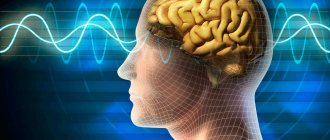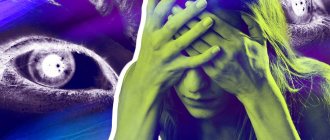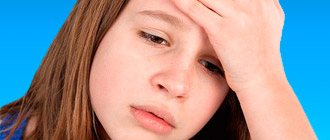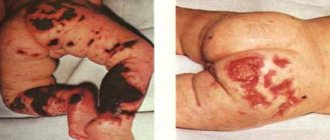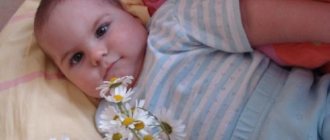Adolescence is a period of life when the formation of a person’s character traits occurs.
The child’s psyche at this moment is unstable and vulnerable. Modern teenagers are distinguished by their penchant for maximalism, demonstrative protest, and oppositional behavior. During adolescence, human emotions are very changeable and fickle. It is for this reason that some adolescents begin to develop primary mental disorders. Schizophrenia is one of the pathologies that rapidly develops at this stage.
For many, this mental disorder is associated with such unpleasant manifestations as:
- madness;
- antisocial behavior;
- maladjustment in society;
- insulation;
- no future.
To some extent this is true. Late diagnosed or advanced schizophrenia can lead to serious consequences. Fortunately, these are isolated cases.
Modern methods of diagnosing and treating mental disorders help patients lead a normal lifestyle without losing its quality.
The main task of parents of a teenager is to understand the reason for the change in behavior and seek help in time.
Causes of teenage schizophrenia
The main factor in the development of this mental disorder is heredity. Scientists have identified a number of genes that convey a predisposition to schizophrenia. But this is far from the only source of the disease.
Psychiatrists argue that there are also a number of biological and psychosocial prerequisites. Most often there are several triggers. The most common causes of schizophrenia in adolescents:
- parental divorce;
- frequent quarrels in the family;
- severe stress;
- any type of violence – physical, psychological, sexual;
- taking a large dose of alcohol or drugs for the first time;
- traumatic brain injury.
Statistics show that boys are diagnosed with schizophrenia twice as often as girls at the same age. The reason for this pattern is unknown.
GENERAL CONCEPT OF THE DISEASE, FEATURES OF ITS SYMPTOMATICS
The childhood type of schizophrenia is a type of mental illness that manifests itself at an early age and is characterized by the same symptoms as its adult form. Pathology affects the behavior, emotional state, and thinking of the child, which leads to his incorrect interpretation of the surrounding reality.
Obvious symptoms of mental disorder most often appear upon reaching the age of 7. In some cases, the disease can be diagnosed already in the first year of a baby’s life.
Signs of schizophrenia in children and adolescents are not easily classified. Therefore, the final diagnosis and subsequent treatment of the patient should be made by a psychiatrist who has sufficient experience in working with such patients.
The onset of the schizophrenic process occurs at an age when the mental consciousness of an individual is just beginning to develop. Therefore, the symptoms of childhood pathology have the following specificity:
- unclear clinical manifestation. Signs of schizophrenic illness in children do not reach the level of mature pathology. However, an experienced specialist is able to determine the risk group even in infants from one year old;
- Teenagers are prone to fantasizing and philosophizing. Their desire for an associative lifestyle does not always indicate the presence of an illness, but may be a “mirroring” of a negative environment;
- instability of development. It lies in the fact that in the life of a minor member of society there are alternating periods of advance of normal personality formation and those that are characterized by obvious developmental delays.
First manifestations
The initial signs of schizophrenia in a teenager can be noticed in childhood. But they are irregular and expressed sporadically, so parents attribute them to some individual character traits, fatigue or moodiness. Besides, it’s hardly anyone’s pleasure to suspect their own child has a mental disorder.
It will not be difficult to see changes in a child’s behavior if he led an energetic lifestyle: he studied well, actively communicated with friends, was interested in sports or other hobby activities. But suddenly some event occurs that radically changes his life. He ceases to be interested in studies, he does not find common topics for conversation with friends, he refuses to play sports or previously loved activities.
The teenager withdraws into himself, his behavior becomes unpredictable. The mood can change in the opposite direction in seconds.
The reason for visiting a psychiatrist should be the following, repeatedly occurring symptoms:
- Progressive ridiculous ideas and strange reasoning.
- Changes in the logic of thinking, transformation of speech.
- Craving for absurd fantasies, absurd philosophizing.
- Emotional alienation even from close people, absence or inconsistency of reaction to current events.
- Atypical and absurd use of words and expressions in conversation.
- Irritability for no apparent reason, deceit, manifestation of causeless aggression.
- Inactivity, apathy, lack of any initiative and interest in life.
- Tendency to alienate, categorical refusal to go out, neglect of personal hygiene, sloppiness, carelessness in clothing.
- Unusual phobias and fears, eating disorders, strange hobbies or accumulation of unnecessary things.
- Consumption of alcohol, drugs, tendency to vagrancy.
- Talk about suicide.
A rather characteristic manifestation of a mental disorder should be noted ostentatious hostility towards parents or one of them who was especially close.
FORMS AND DIAGNOSTICS OF CHILDHOOD SCHIZOPHRENIA
When diagnosing this mental illness, the psychiatrist does not focus on one sign, but on their complexity, speed of development and order of manifestation. In cases where the psyche is only at the stage of development, it is extremely important to do this in a timely and qualified manner.
Depending on the symptoms, the childhood and adolescent form of schizophrenia has the following forms:
- simple. The leading symptoms are emotional impoverishment, depression of will and motivation. There are no delusions or hallucinations. Children with mental disorders of this form are most amenable to treatment;
- paranoid. A distinctive feature of this form of the disease is the presence of delusions, which are associated with an incorrect interpretation of various events and experiences - the teenager thinks that he has many defects in appearance;
- hebephrenic. Characterized by excessive impulsiveness, pretentious antics, protest, aggressive behavior towards oneself and others. A delay in treatment of such children leads to an almost complete loss of their ability to learn;
- residual. There are no acute manifestations of the disease, but there remains indifference to one’s appearance, low rates of social activity, and general lethargy;
- catatonic. This form is characterized by disturbances in the motor sphere - the teenager either moves excessively actively, senselessly, or, conversely, freezes in one position for a long time. States of violence are abruptly replaced by periods of apathy. Hallucinations and delusions become more active.
You should look not only at the time of exacerbation of the disease, but also in the interictal periods. A doctor can make an accurate diagnosis only after dynamic monitoring of the patient over a certain period of time.
Symptoms of childhood mental pathology are not specific; only their interrelation and complexity have features. Therefore, it is incorrect to diagnose this mental pathology based on only one or several signs of schizophrenia in children. This insidious disease, at first glance, may look like depression, neurosis or childhood dementia.
The first symptoms of the schizophrenic process can be detected by a practicing psychologist after a conversation with the patient, during which the doctor performs a pathopsychological examination. It consists of testing the cognitive processes that the child undergoes. Thanks to this, disturbances in the area of thinking can be detected already in the early stages of the development of the disease.
An accompanying modern method for diagnosing mental disorders is neurotesting. With its help, the doctor examines blood samples. In schizophrenics, the level of the studied substances is increased, which makes it possible to make a final diagnosis.
Symptoms
The signs of schizophrenia in adolescents are not very different from its manifestations in adults. Most often this is the same delusion, hallucinations, personality disorder.
One can observe rudimentary delusional distortions of thinking in the form of various fears and phobias. They are intrusive and literally pursue the patient. Among them are:
- Fear of other people's parents. The child begins to suspect his own parents that they are not his own. He is afraid of them, does not make contact, and refuses to eat.
- Fear of contamination, which is often accompanied by compulsive hand washing. The teenager does this at every opportunity, regardless of his location.
- Fear of open space – agoraphobia. The patient wants to hide somewhere, to become invisible.
Attention should be paid to the adequacy of the child’s reaction. It happens that to a situation that should make a person sad or upset, he reacts with a fit of laughter and feigned fun. The most common emotional disorders are:
- fenced off;
- isolation;
- absence of any manifestations of emotions, monotonous reaction to events happening around;
- loss of interest in previously favorite activities.
On the part of motor disorders, there may be repeated stereotypical movements, freezing in some unnatural positions, poor posture, strange gait, etc. Sometimes the angularity and awkwardness of movements can be attributed to adolescence or the accelerated growth of a teenager. But this pattern only works if the child has only these manifestations and they do not get worse over time.
Schizophrenia in adolescents
It can manifest itself between the ages of 7 and 10, but, as practice shows, it is more often observed at the age of 12-16, precisely during the transitional period of adolescence, when hormonal changes occur in the body.
Signs of schizophrenia in adolescents:
- The emergence of harmful habits - drug and alcohol use. The teenager begins to actively take all kinds of psychotropic drugs. If parents do not respond in time, the risk of developing chemical dependency is high.
- Gross violations of behavior. In terms of scale and categoricalness, they differ significantly from children's ones. Such children can demonstratively show their protest by refusing to wash themselves, showing a desire to walk around in dirty and torn clothes, cruelly mocking their peers, stealing and engaging in other crimes. In other words, they simply begin to ignore social norms and principles.
Doctor's experience:
I had a patient with hebephrenic schizophrenia - an 8-year-old boy. He was very aggressive towards everyone around him. For example, by the age of 6, he pierced his brother’s hand with a fork, as a result of which he was sent to a psychiatric hospital for treatment. At the age of 8, other deviations began to appear - he behaved, one might say, “like a fool”: he constantly made faces, fooled around, found himself completely absent from his studies, later he began to hear some voices, and got into fights with children. Over time, the primary diagnosis gave way to paranoia, which began to be accompanied by the development of dementia and severe thinking impairment.
Despite the fact that medical therapy slowed the progression of the disease, it was not possible to completely eliminate the negative symptoms. The main thing is that the child was under the supervision of experienced specialists. After all, many other children with this diagnosis end up in a more deplorable state - they become addicted to drugs and die from an overdose, end up in prison because of their inappropriate behavior.
Stages of the disorder
Whatever the causes of schizophrenia in adolescents, it begins slowly and imperceptibly. One of the first manifestations is a feeling of internal discomfort. It has no reason, but keeps a person in constant stress and tension.
The following stages of development of the disorder and the measures taken should be highlighted:
- Prodromal. At this stage of the disease, adolescents are characterized by problems associated with concentration, sleep disturbances, and difficulties at school. Making a diagnosis of schizophrenia at this stage is impossible; the goal of the diagnostic process is to form specific risk groups and carry out specific prevention.
- Spicy. Productive symptoms predominate: hallucinations, delusions, disorders of formal thinking, strange psychotic behavior. The most specific are auditory hallucinations. They occur in 80% of patients aged 12 to 18 years.
- Response to treatment and reduction of symptoms of the disease. The goal of therapy at this stage is to monitor and correct side effects of therapy and achieve remission.
- Maturing remission. There are residual positive and negative symptoms of schizophrenia associated with side effects of therapy. At this stage, stable remission is achieved, factors that may cause a relapse are eliminated, a commitment to long-term maintenance therapy is formed, and social functioning is restored.
- Recovery. At this level, monitoring of compliance with the maintenance therapy regimen, social support, and relapse prevention are carried out.
- Chronic. The progression of this stage indicates the teenager’s resistance to the treatment methods used. Deactualization and partial reduction of positive symptoms occur, but social isolation, apathy and abulia persist. Negative symptoms cause a child's low level of social functioning.
Schizophrenia affects the most subtle layers of a teenager’s psyche and manifests itself in the sphere of self-awareness and perception of the surrounding reality.
Features of the course of the disease
Schizophrenia in adolescents has very similar symptoms to the adult type of the disease. However, when started early, it has a more malignant course, especially in males.
During puberty, a person’s sexual sphere is finally formed, and the perception of one’s own gender identity is formed. Sexual activity is usually limited to intense self-gratification, and the teenager does not particularly hide this fact.
There is an opinion that schizophrenics are dangerous to society; this theory is greatly exaggerated. A person suffering from a mental disorder is much more dangerous to himself than to others. If he finds himself in a criminal situation, it is most likely as a victim. The tendency to aggression can manifest itself only in the acute period under the influence of hallucinations.
Diagnostics
Where to turn first if there is a suspicion that a teenager has a worsening mental disorder? The initial examination can be carried out by any of the following specialists:
- psychologist;
- psychiatrist;
- neurologist;
- neuropsychologist;
- speech pathologist
Having studied the symptoms, the doctor refers the patient for further examination to identify concomitant somatic disorders.
Parents must be involved in the process of fighting the disease. For effective interaction between a doctor and a teenager, one should remember the specificity of adolescence, as well as the individual characteristics of the patient.
The doctor's task:
- show a tolerant attitude towards the child, recognize the naturalness of his anxiety, tension and suspicion, express understanding about the teenager’s reluctance to communicate with a psychiatrist;
- take into account possible obstacles to a teenager’s perception of information, in particular due to the presence of verbal hallucinations and severe impairments in the concentration function of attention;
- always listen carefully to the patient, take seriously any information provided, ask about details, using the terms he uses;
- maintain an optimal distance with the child, taking into account his needs for personal space, for example, do not mind if it is easier for the patient to talk to you while playing, walking around the office;
- demonstrate a desire to help;
- Explain in detail to the child and parents what the procedure for assessing the child’s condition will be;
- collect information gradually, as trust is formed on the part of the child and his parents;
- introduce the teenager and his parents to specialists who will participate in the implementation of psychosocial intervention.
A specialist who provides qualified psychiatric care to a child with schizophrenia must take into account the stage of its development, the severity and mechanisms of disorders of adaptive behavior, the presence of special educational problems, and the situation in the family context.
Course of the disease up to 12 years: causes, symptoms
Schizophrenia occurs for internal reasons and with an external “trigger”. Main internal reasons:
- maternal infections during pregnancy;
- perinatal malnutrition;
- genetic predisposition - if there is a family history of schizophrenia or other mental pathologies;
- birth injuries, asphyxia;
- perinatal infections, placental abruption, placental insufficiency;
- trigger medications (in young children - stimulants or corticosteroids, in adolescence - addictive drugs);
- infection of the child’s central nervous system after childbirth;
- pathologies of the thyroid gland;
- brain injuries in early childhood.
Triggers include: drug use or dangerous medications, frequent stress. Children prone to developing schizophrenia are distinguished by some special features. They have no problems with cognitive functions and intelligence, but there is underdevelopment of practical activities. That is, a preschooler is not able to perform simple self-service actions.
This child is likely to avoid activities that involve physical activity and interaction with others. He will choose a calm game, during which he does not need to move much. A child prone to illness is very selective in choosing interlocutors. He often has a sad, depressive mood without objective external reasons. In a problematic situation, such a child is more likely to withdraw into himself without showing emotions.
Depending on the age stage, the first symptoms of the disorder appear as follows. From 0 to 3 years:
- the baby has a focused, serious look, uncharacteristic of other babies;
- sleep intervals are short;
- difficulties in determining where the baby is looking are typical;
- there is a delay in the development of basic motor skills and speech abilities;
- the baby is characterized by hypersensitivity to loud voices, music, noise;
- increased fearfulness;
- excessive irritability;
- difficulties arise in calming the baby's crying;
- lack of emotional warmth towards mom or dad - the baby is not happy when he is hugged or picked up.
At 1-3 years old, features of the motor sphere are noticeable: walking in a circle or from right to left, unmotivated impulsiveness. A preschooler with schizophrenia is able to cry or laugh without the slightest external reason. Fears also arise for no reason, sometimes accompanied by motor excitement. At 2-3 years of age, fear becomes “objective.” The baby begins to be afraid of something specifically: cars, the street, the entrance, etc. If you ask “why are you afraid of this?”, the baby will begin to deny fear.
From 3 to 5–7 years, new symptoms appear:
- fantasizing takes on a strange appearance and takes up a lot of conversational time;
- the presence of phobias of an unusual nature (phobia of shadows, flowers, trees);
- increased anxiety without objective reasons;
- strange “premonitions” about the life and health of relatives - for example, a child declares that “dad will be killed,” “mom will go to the hospital and die there,” etc.;
- new “habits” arise - obsessive rhyming of words, composing new words of an aimless and obsessive nature;
- tendency towards “asociality” - pronunciation of swear words, dangerous behavior, aggressiveness;
- frightening dreams, sometimes of a recurring nature;
- problems falling asleep;
- drives become ambivalent - the preschooler experiences an obsessive desire to touch a hot stove, but at the same time he also shows fear of it.
At 5-6 years old, any child begins to ask interesting questions about life and the world around him. But in a child with schizophrenia, questions become obsessive - he asks the same thing over and over again. There is philosophizing in reflection.
At 6-7 years old, negativism towards people and family members arises. The child shows severe anxiety and fussiness if there is a “unlikable” person nearby. There is a noticeable desire to cause harm: pushing, pinching, hitting. Hostility sometimes manifests itself in the fact that a student urinates or defecates on the shoes or clothes of an “unlikable” person. Gradually, negative feelings towards food and fear of having lunch or dinner arise. Sleep in childhood schizophrenia is disturbed - it is significantly shortened.
Until the age of 7, delusional thinking and hallucinatory phenomena almost never develop. After 7 years, a number of new symptoms appear:
- sleep disorders become chronic;
- impaired concentration of attention is noticeable during learning;
- the patient avoids contact with people, does not communicate, and often spends time alone;
- problems with speech - incoherence, choppiness;
- during the acute phase of the disease, the patient claims to have superpowers or talks about being followed;
- a psychotic episode involves unpredictable, dangerous, aggressive behavior - the child is capable of harming himself or other people;
- hallucinations gradually appear - first the patient claims to hear voices in his head, then visual visions appear.
In the presence of schizophrenia, symptoms are noticeable not only during the attack, but also during the interictal time. To establish a diagnosis, it is important to observe the patient's behavior over time.
Productive symptoms are not as pronounced as in adults. Most often it is limited to pathological fantasizing, fears, motor disorders, and speech disorders. The child's sleep, appetite and behavior are often disturbed. Nightmarish visions and manifestations of autonomic dysfunction are observed.




